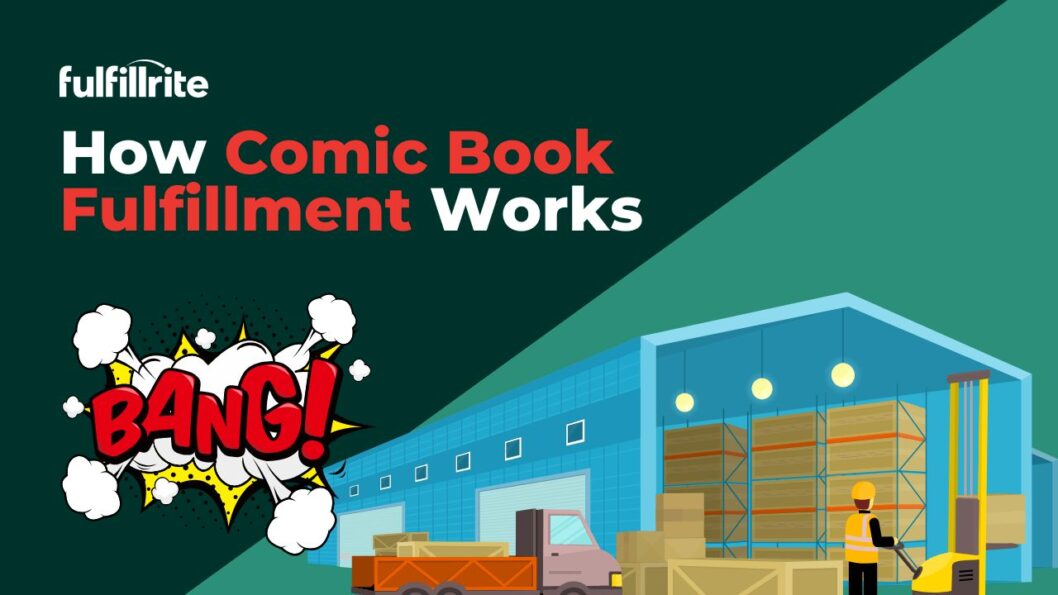Selling your comic is an incredible milestone. It means people believe in your work enough to pay for it. But the work doesn’t stop at “sold.”
Now you have to ship it.
Whether you’re dealing with 20 local orders or 2,000 international backers, comics fulfillment is where creators make or break their reputations. A bent corner, a late delivery, or a missing variant can turn a happy customer into a vocal critic. And that’s just not fair to you.
That’s why it’s critical to understand how comics fulfillment works, what your options are, and when it makes sense to bring in help. This guide will walk you through the essentials—from what comics fulfillment actually involves to how distribution fits in and what to look for in a reliable partner.
If you’re wondering whether you can handle it all yourself, or need someone like Fulfillrite to take it off your plate, read on.
What is comics fulfillment?
At its core, comics fulfillment means storing, packing, and shipping your comic book to customers or backers. That sounds simple, but in practice, it’s one of the most technically demanding parts of running a self-publishing operation.
There are four core responsibilities involved in fulfillment:
- Inventory management. You need to store your books in a clean, organized space that won’t damage them. You’ll need to keep them away from humidity, dust, or accidental spills. You also need to track what’s in stock, what’s sold, and what needs restocking.
- Packaging. Comics require special handling. A paperback novel might survive a bubble mailer. A comic book won’t. If you don’t use rigid mailers, bag-and-board protection, and proper sealing, your books will get damaged in transit.
- Labeling and shipping. Every order needs accurate address labeling, postage calculation, and tracking. U.S. orders might go out via Media Mail. International shipments require customs forms. That’s time-consuming and error-prone, especially in bulk.
- Customer communication. People expect tracking updates. They want to know when something ships. And if a package gets lost or bent, they’ll come to you. Fast response matters and bad experiences spread quickly.
For self-publishers, this becomes especially complex during crowdfunding. A Kickstarter may involve 10 reward tiers, 3 variant covers, foil upgrades, stretch goal pins, signed inserts… and all of it has to arrive in one neat, perfect bundle, on time.
DIY comics fulfillment vs fulfillment services
Should you fulfill your comic yourself or hire help?
There’s no single answer, but there is a tipping point where doing it all alone stops being cost-effective or manageable.
Let’s compare the two.
DIY Comics Fulfillment
Pros:
- Total control. You see every order, pack it yourself, and double-check the condition of every copy.
- Lower cost (at small scale). If you’re only shipping a few dozen or even a few hundred books, buying your own materials and printing postage can be cheaper than hiring a third-party service.
Cons:
- Labor-intensive. Packing 200+ orders takes days. More if you have bundles or stretch goals.
- Higher error risk. One wrong label, one missed sticker, one bent comic, and you’re reshipping on your dime.
- No scalability. Once your campaign passes 100 backers or multiple reward tiers, fulfillment becomes a full-time job. It slows down your next project. And your creativity.
Fulfillment Services
Hiring a comics fulfillment service means offloading the shipping process to professionals who handle packing, labeling, inventory tracking, and carrier coordination on your behalf.
Pros:
- Saves time. You focus on creating and promoting. They handle logistics.
- More accurate. Barcode scanning, weight checks, and order verification reduce errors dramatically.
- Better packaging. Pros use rigid mailers, corner protection, and proven processes that reduce damage.
- Easier international shipping. Customs prep, DDP (delivered duty paid), and carrier selection are handled for you.
- Real-time tracking. You get a dashboard showing what shipped, what’s in stock, and what’s pending.
Cons:
- More expensive upfront. Fulfillment centers charge per order, usually between $2 and $5 depending on complexity (plus postage).
- Less personal control. You don’t touch every copy before it ships, so trust is essential.
For creators shipping fewer than a few hundred orders, DIY is still a decent choice. But once you’re moving serious volume, or trying to run multiple campaigns a year, working with a comics fulfillment center makes a lot more sense.
What to look for in a comics fulfillment company
Let’s say you’ve decided to work with a fulfillment partner. That’s a smart move. But not all services are equal. You need someone who understands comics, not just shipping.
Here’s what to look for when evaluating comics fulfillment services:
1. Experience with comics and collectibles
Shipping comics is different from shipping T-shirts or coffee mugs. You need a partner who knows how collectors think and how fragile your product actually is. If your fulfillment company can’t tell a Gemini mailer from a poly bag, that’s a red flag.
Ask for examples. Have they worked with other comic campaigns? How many SKUs have they handled at once? Do they understand variant covers, signed bookplates, and foil inserts?
2. Use of rigid mailers and corner protection
This one’s non-negotiable.
Comics should never be shipped in soft packaging. If your book isn’t bagged, boarded, and packed in a rigid mailer, it’s going to arrive bent. And if it arrives bent, you’re going to hear about it.
A good fulfillment center should default to rigid mailers. Even better if they offer options like Gemini, StayFlat, or custom-branded packaging.
Bonus: climate-controlled storage. Especially in humid climates, proper storage matters. Warped covers and sticking ink are real problems for unprotected books.
3. SKU and variant tracking
If you’re offering multiple covers, stretch goal add-ons, or digital/physical reward splits, you need clean inventory tracking.
Good fulfillment companies use barcode systems that scan every item going into a box. That’s how they ensure the right reader gets the right book, sticker, pin, and note.
If your campaign has more than three tiers or variants, this becomes critical.
4. Custom kitting (signed bookplates, pins, bonus content)
Your book may not ship alone. It might be bundled with:
- Signed inserts
- Foil stickers
- Enamel pins
- Patch sets
- Postcards
- Zines
- Or all of the above
Each order might have a slightly different bundle. You need a service that offers kitting, the process of assembling these bundles before shipping, and does it accurately.
5. Launch-day precision
Some creators ship in waves. Others plan a big, coordinated drop: every order goes out the day the book is released.
If you’re doing the latter—especially for crowdfunded campaigns or con debuts—your fulfillment partner must be able to support scheduled mass shipping. This requires pre-kitting, staged inventory, and a team ready to go.
If your book arrives days late, it’s not just annoying. It can cost you press momentum and repeat backers.
6. Transparent pricing
Ask for a detailed breakdown of costs:
- Storage per pallet or SKU
- Pick and pack fee per order
- Kitting fees (if any)
- Packaging material costs
- Label/postage costs (do they mark it up?)
- Monthly platform or account fees
Some fulfillment services nickel-and-dime you. Others build costs into one per-order rate. Either is fine as long as it’s clear, consistent, and predictable.
Comics fulfillment and distribution
People often confuse fulfillment and distribution. They’re related, but different.
Here’s the basic split:
- Fulfillment = shipping individual orders to readers, backers, or subscribers
- Distribution = shipping bulk quantities to retailers, stores, libraries, or conventions
If you’re fulfilling a Kickstarter campaign with 600 backers, that’s fulfillment.
If you’re sending 50 copies to your local comic shop chain or a distributor like Diamond or Lunar, that’s distribution.
Sometimes you need both—especially if your campaign includes:
- A retailer pledge tier (e.g. “10 copies at wholesale discount”)
- A post-campaign sales plan through local stores
- A convention vendor table that needs pre-shipped inventory
Some fulfillment services handle both. Others only do one.
Fulfillrite offers both comics fulfillment and distribution support. That means we can ship individual packages and send out bulk shipments to retailers or your con hotel—no need to switch services.
End-to-end comics printing and fulfillment
A question that comes up a lot, especially from first-time creators, is this:
Can I print and ship my comics all from one place?
The answer? Sometimes.
But usually, the best results come from using a dedicated printer and a separate, experienced comics fulfillment center that can coordinate closely with your print partner.
What does “end-to-end” fulfillment mean?
“End-to-end” typically refers to a process where one company (or a tightly coordinated team) handles everything from receiving your printed books to packing and shipping every order. That includes:
- Receiving your shipment from the printer
- Storing your inventory securely
- Organizing SKUs and extras
- Kitting bundles or custom orders
- Printing shipping labels
- Handling returns, tracking, and customer service
It doesn’t always mean the printer and fulfillment center are the same company, but it does mean they talk to each other, and the handoff is seamless.
That’s what real end-to-end logistics feels like: smooth, predictable, hands-off after launch.
Should I use a printer that offers fulfillment too?
Some printers advertise in-house fulfillment services. That sounds convenient—but it’s worth checking the fine print.
Most printers don’t specialize in comics. They may do basic pick-and-pack services, but they often lack:
- Rigid mailers or bag-and-board standards
- SKU tracking for variants
- Kitting for stretch goal rewards
- Experience with collector expectations
- Timely launch-day coordination
- International shipping workflows or customs prep
This leads to damaged orders, shipping delays, and frustrated backers.
If you’re only selling through Amazon or handing out books at cons, printer-fulfillment might work fine. But if you’re managing dozens of reward tiers and a large audience of collectors or international fans? Use a fulfillment company that lives and breathes this work.
Final Thoughts
Every order represents a fan who believed in your story. They backed your campaign. Or bought your book online. Or found you at a con and wanted to read more. How you deliver that book shapes how they remember you.
So, what are your options?
You can do it yourself—and if you’re starting small, that’s fine. Just know the risks: burnout, damaged books, missed deadlines. The cost of DIY is higher than it looks.
Or, you can work with a partner who’s done this hundreds of times. Someone who understands the stakes. Someone who treats your book like it matters.
Fulfillrite is that partner. We specialize in comics fulfillment for self-publishers, indie creators, and crowdfunders. Whether you’re sending out 50 signed issues or launching a 2,000-backer campaign, we’ll help you get it right—on time, intact, and with zero chaos.

